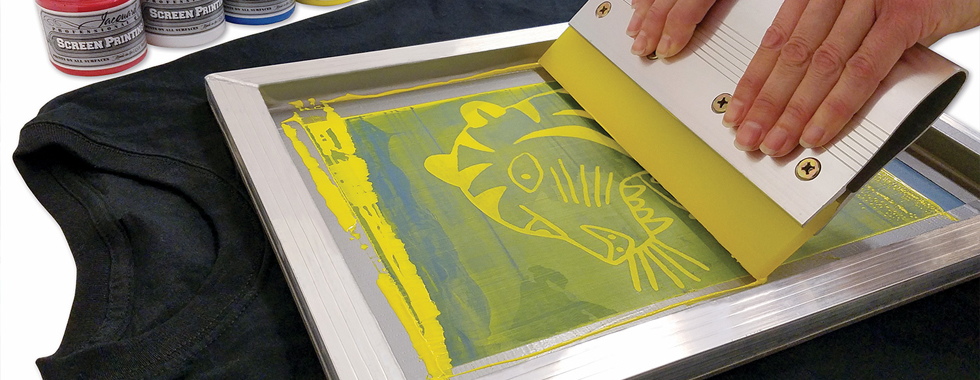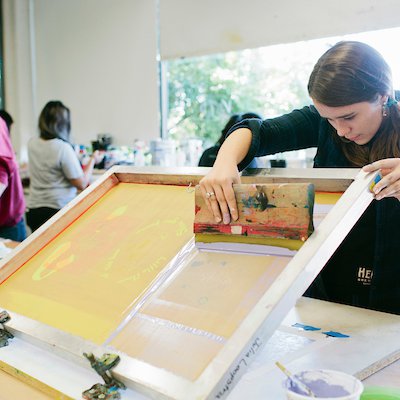The Important Guide to Recognizing Screen Printing and Its Versatile Uses
Screen printing has a rich history that dates back to old times, evolving right into an innovative method made use of across different markets today. This guide explores the complexities of the screen printing process, detailing its applications in home, advertising, and style design - 10:9 Design Screen Printing. Comprehending these fundamentals can open imaginative potential for both industrial and creative projects. The following sections will certainly reveal crucial ideas and strategies to enhance one's screen printing endeavors
The History of Screen Printing
Although screen printing has origins that map back centuries, its advancement shows the technical and creative improvements of different societies. Coming from old China, the method was originally made use of for decorating fabrics and later spread to Japan, where it became indispensable to Ukiyo-e woodblock printing. The technique changed to Europe in the 18th century, where it got popularity amongst craftsmens and industrial printers. The innovation of photo solution in the 20th century changed screen printing, enabling even more detailed styles and higher performance. Artists like Andy Warhol better drove its popularity, utilizing the medium to produce famous jobs that mixed commercialism and art. By the late 20th century, screen printing had actually established itself as a functional strategy, utilized in vogue, advertising, and great art. Today, it proceeds to evolve, incorporating digital innovation and increasing its applications throughout different industries.
The Screen Printing Refine Explained
Screen printing transforms creative visions into concrete designs via a series of exact actions. Initially, a photo is created and after that moved onto a screen, normally made from fine mesh fabric extended over a frame. A light-sensitive solution is put on the screen, which is revealed to light, solidifying in areas not covered by the image. After rinsing the unhardened emulsion, a stencil is created.
Next, the screen is positioned over the substratum, whether it be textile, paper, or one more product. Ink is after that pushed via the open locations of the stencil utilizing a squeegee, depositing the layout onto the substratum below. This procedure can be duplicated for multiple shades, requiring different screens for each tone. Ultimately, the printed thing is treated utilizing warmth to assure the ink sticks properly, resulting in a sturdy, vibrant style all set for use.
Kinds of Screen Printing Techniques

In addition, specialty techniques, such as discharge screen printing, eliminate dye from the textile to develop softer prints, while foil screen printing uses metal aluminum foil to accomplish a glossy coating (10:9 Design Embroidery). Each technique offers distinctive qualities, dealing with various innovative demands and production scales, ultimately increasing the possibilities within the screen printing domain name
Applications of Screen Printing in Numerous Industries

In addition, the signs and advertising sectors use screen printing for creating captivating displays and banners. This method enables bold shades and complex layouts that record view it attention. In electronics, screen printing is used for using conductive inks to circuit card, important for element connections. In addition, the home décor sector accepts screen printing to generate distinct layouts on fabrics and wall art. Overall, screen printing functions as an important device across diverse areas, improving items with personalized and visually appealing graphics.
Tips for Successful Screen Printing Projects
While undertaking a screen printing job, careful interest to information can significantly boost the final outcome. Initially, choosing premium products is necessary; this includes the screen, inks, and substratums. Utilizing ideal mesh counts can influence ink deposition and information resolution. Preparation is similarly essential; complete cleaning of screens and correct exposure times guarantee crisp prints.
Next off, accurate registration is important for multi-color prints. Utilizing placement tools can assist accomplish exact layering. Furthermore, screening prints on scrap products before manufacturing assists recognize possible concerns without wasting sources.

Often Asked Concerns
What Products Are Best for Screen Printing on Textile?
Cotton and polyester blends are perfect for screen printing on fabric as a result of their resilience and ink absorption. Additionally, specialized materials like silk or canvas can generate special here are the findings appearances and coatings, improving the total style quality.
How Do I Tidy and Maintain Screen Printing Devices?
To keep and cleanse screen printing equipment, one must consistently wash displays with ideal solvents, evaluate squeegees for wear, lube relocating parts, and shop all items in a completely dry, dust-free environment to prolong their life-span.
What Are the Environmental Impacts of Screen Printing?
Screen printing can have substantial environmental influences, including chemical waste from solvents and inks, water use throughout cleaning procedures, and power consumption. Sustainable methods and environment-friendly products are important for lessening these unfavorable effects.
Can Screen Printing Be Done at Home Properly?
Screen printing can be properly done at home with the ideal products and methods. Hobbyists can develop top quality prints, though success relies on their ability level, devices, and understanding of the procedure included.
What Are the Prices Connected With Starting a Screen Printing Organization?

Beginning a screen printing organization includes costs for devices, materials, and workspace. First expenditures normally vary from a few hundred to a number of thousand bucks, depending on the scale, top quality of machinery, and preferred production capacity.
Screen printing has an abundant history that dates back to ancient times, developing visit homepage right into an innovative technique utilized across numerous industries today. An additional method, rotating screen printing, utilizes round screens, facilitating constant printing on fabric rolls, thereby improving efficiency for large productions. Furthermore, specialized techniques, such as discharge screen printing, eliminate color from the textile to develop softer prints, while aluminum foil screen printing uses metal aluminum foil to achieve a glossy coating. In the style market, screen printing is extensively utilized to produce vibrant layouts on garments, enabling brand names to display their special styles. Cotton and polyester blends are ideal for screen printing on textile due to their sturdiness and ink absorption.